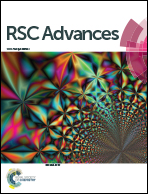mpg-C3N4/anatase TiO2 with reactive {001} facets composites to enhance the photocatalytic activity of organic dye degradation
Abstract
mpg-C3N4/anatase TiO2 with reactive {001} facets composites were synthesized via a facile ultrasonic dispersion method. Incorporation of mpg-C3N4 into anatase TiO2 was successfully confirmed by X-ray diffraction (XRD). The percentage of exposed {001} facets in TiO2 calculated from the Raman spectra was 80.6%. The microstructure and optical properties of the as-prepared samples were characterized by scanning electron microscopy (SEM), transmission electron microscopy (TEM), nitrogen adsorption–desorption isotherms, UV-vis diffuse reflectance spectra (DRS) and photoluminescence (PL) spectroscopy. The effects of mass ratios of mpg-C3N4/(TiO2 + mpg-C3N4) on the photocatalytic activities of the mpg-C3N4/TiO2 composites were investigated. The photocatalytic experiments indicated that the mpg-C3N4/TiO2 composites showed a much higher photocatalytic activity than the pristine TiO2 and mpg-C3N4 for the degradation of methylene blue (MB) under UV light and visible light irradiation. This enhancement should be attributed to the reactive {001} facets of TiO2 and the heterojunction formed at the interface between anatase TiO2 and mpg-C3N4, thus resulting in a much lower recombination rate of the photoinduced electrons and holes. Compared with the decolorization process, mineralization is slower. The degradation of 2,4-dichlorophenol suggests that the dye sensitization is not the main cause of dye degradation. In addition, the quenching effects of different scavengers proved that the superoxide radicals (˙O2−) and holes (h+) were the main factors for the improved photoactivity under UV-light, while the superoxide radicals (˙O2−) play important roles in the photocatalytic reaction under visible light irradiation. Repeatability experiments of MB degradation suggest that the mpg-C3N4/TiO2 composites have high stability. The photocatalytic degradations of MB, RhB and MO were measured under UV and visible light irradiation and the photocatalytic degradation efficiency was found to be in the decreasing order of RhB > MB > MO. These results indicate that the incorporation of mpg-C3N4 into anatase TiO2 with reactive {001} facets is an effective method to improve the photocatalytic activity under both UV and visible light.


 Please wait while we load your content...
Please wait while we load your content...